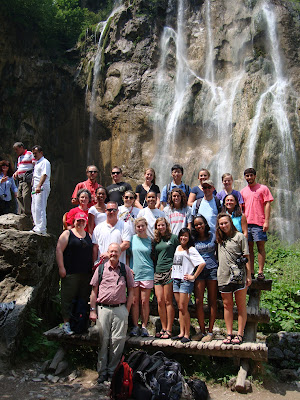Morgan
It is an incredible realization when I come to the conclusion that it is likely that every night here in Croatia I will be able to say, “Today was a good day”. Our day began when we boarded quite possibly the most comfortable coach bus of all time. For the first leg of our travel our professors gave brief lectures on the bus that were pertinent to the day’s outings. Following these impromptu class sessions (and a quick nap), we arrived at our main destination: Plitvice Lake Park. As one of Croatia’s World Heritage sites, the park offers expansive birch and spruce forests, rolling meadows and, perhaps most notably, a breathtaking 16 lake system, which is connected by stunning waterfalls, as pictured above. When we unloaded our bus, we were met by our guide Mr. Kresmir Culinovic. Having prepared a presentation highlighting the fundamental value and historical significance of the entire park, Mr. Kresmir proved to be the most knowledgeable of guides. The lake system covers a mere 1% of the park, yet it’s striking aesthetics draws upward of one million visitors annually. As a group we explored the “lower” and “middle” lake sections of Plitvice.
We caught a bus from the park entrance to a high mountainside overlooking the lakes. From here, our group seemingly scaled the mountainside until we reached a path along the shores of the lower lakes and ended at a massive waterfall, which was fed by the Plitvic River. The group gathered to take a photo under the falls, which is attached. Our journey along the lake system ended when we walked back up to the largest lake, found in the central section. We caught an electric ferry across the lake where the only thing that stood between us was another uphill climb.
As we have already reiterated, the smoking rates here are sky high. Having observed this widespread use throughout the urban areas in Zagreb, it was interesting to find a seemingly less prevalence of cigarette smoking in the region surrounding Plitvice Park. This may simply be attributed to the lower population density in the area, but some may point to the indirect effects that recreational areas, such as Plitvice Park, can have on it’s surrounding community. During lecture on the bus, Dr. Cotton mentioned the benefits of a community with the presence of park areas or other recreational spaces. The link between wellness and such spaces can be seen in the citizens’ sense of identity with the parks. The idea of stewardship provides a sense of pride, which is directly linked with a reduction in crime and an increase of volunteerism. The activity possibilities these areas offer can also lead to increased levels of physical activity. Even moderate activity has been found to reduce the size of the proteins that carry low protein lipoproteins, which is often referred to as “bad cholesterol”. Such opportunities have positive affects on everyone who lives near or visits the parks.
Something else Andie referenced in her earlier post is the inadequate access for those with disabilities in Zagreb. Unfortunately, today we became aware that this issue is not isolated to the capital city. It is important to note that Plitvice Park is located in the heart of the mountainous Karst region in central Croatia, yet there seemed to be very little effort to make the park accessible to those with disabilities in the least. All of the paths, be in the mountainside or along the shores of the lakes, were rugged, uneven, and lacked handrails, as shown in the attached photo. There were no impediments that separated park visitors from either jumping or falling into the water. It is remarkable to note the different standards that exist here compared to those in the United States concerning disability accessibility. It is easy to expect that this will be a topic in many of our posts throughout our stay in this country.
After our fresh fish lunch, we headed back to the Jadran. On our way back into Zagreb, we stopped in the city of Karlovac. Dr. Cotton and Dr. Reap told us before we started our tour that they have been trying for the past several years to establish a permanent UGA institution in Croatia, much like the resources the school owns in Costa Rica and at Oxford. The site that is being considered at this time is located in Karlovac. It was interesting to keep this possibility in mind as we walked through the streets of the city. Our guide, Ivan Zelenic, a geography professor at a small university here in Croatia, took us to several establishments in the town, and also provided us with background information about the regions longstanding and complex history.
After another uphill climb to view a medieval castle, which was cut short by a brief thunderstorm, we were able to take a stroll into the heart of Karlovac. In the town square, our guide further explained his thoughts about the economical and industrial oppression of the city. He attributed the current neglect to society’s inability to focus any thought or resources to anywhere other than the industrial center, Zagreb. Yet, he also voiced opinions that directly blamed the West, specifically the United States, for many of the local downfalls. Dr. Reap later attributed this explanation by stating that the U.S. as a wealthy and powerful nation, is a big and easy target, but also that we are not perfect. When asked why some accuse the West, our study abroad “assistant” from the Pilar Institute, Anja, simply stated “They just want someone to blame”.
Today was an incredible experience that allowed us to observe just another aspect of Croatian heritage. Being able to view the deep historical substance both in Plitvice and Karlovac, allowed us the first opportunity to observe Croat culture outside of the concentration of what is Zagreb. I cannot wait for our next opportunity to explore the seemingly limitless facets of Croatian life.




No comments:
Post a Comment